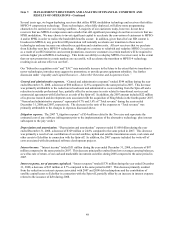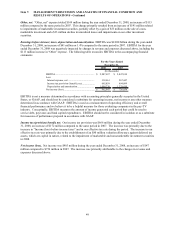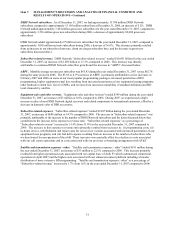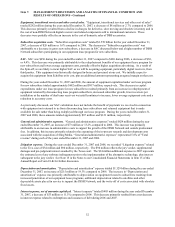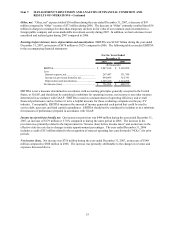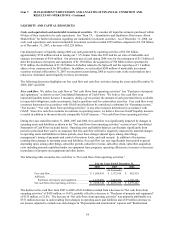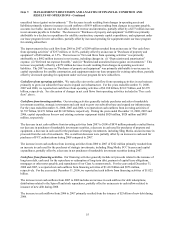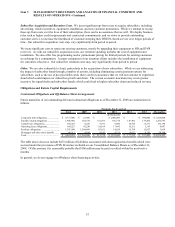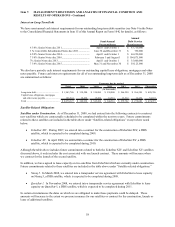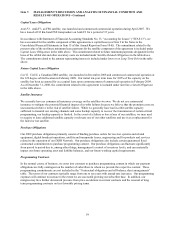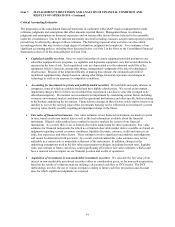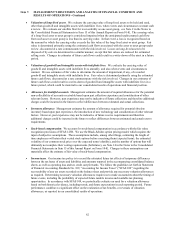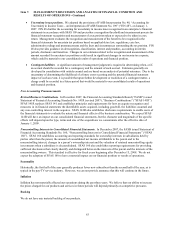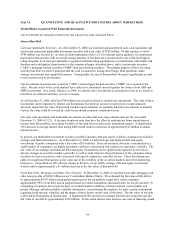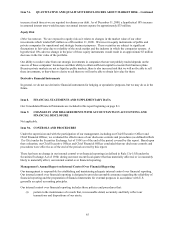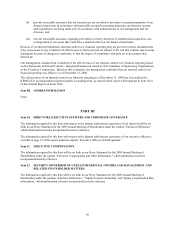Dish Network 2008 Annual Report Download - page 66
Download and view the complete annual report
Please find page 66 of the 2008 Dish Network annual report below. You can navigate through the pages in the report by either clicking on the pages listed below, or by using the keyword search tool below to find specific information within the annual report.
Item 7. MANAGEMENT’S DISCUSSION AND ANALYSIS OF FINANCIAL CONDITION AND
RESULTS OF OPERATIONS - Continued
56
Other Liquidity Items
700 MHz Spectrum. We paid $712 million to acquire certain 700 MHz wireless licenses, which were granted to us
by the FCC in February 2009. We will be required to make significant additional investments or partner with others
to commercialize these licenses and satisfy FCC build-out requirements. Part or all of our licenses may be
terminated if we fail to satisfy these requirements.
Subscriber churn. DISH Network lost approximately 102,000 net subscribers for the year ended December 31,
2008, compared to adding approximately 675,000 net new subscribers during the same period in 2007. This
decrease primarily resulted from the decrease in gross new subscribers and an increase in our subscriber churn rate
of 1.86% compared to 1.70% for the same period in 2007. See “Results of Operations” above for further discussion.
Our distribution relationship with AT&T was a substantial contributor to our gross and net subscriber additions over
the past several years, accounting for approximately 17% of our gross subscriber additions for the year ended
December 31, 2008 and 19% of our gross subscriber additions in the fourth quarter. This distribution relationship
ended on January 31, 2009. AT&T has entered into a new distribution relationship with DirecTV. It may be
difficult for us to develop alternative distribution channels that will fully replace AT&T and if we are unable to do
so, our gross and net subscriber additions may be further impaired, our subscriber churn may increase, and our
results of operations may be adversely affected. In addition, approximately one million of our current subscribers
were acquired through our distribution relationship with AT&T and subscribers acquired through this channel have
historically churned at a higher rate than our overall subscriber base. Although AT&T is not permitted to target
these subscribers for transition to another pay-TV service and we and AT&T are required to maintain bundled
billing and cooperative customer service for these subscribers, these subscribers may still churn at higher than
historical rates following termination of the AT&T distribution relationship.
Satellites. Operation of our subscription television service requires that we have adequate satellite transmission
capacity for the programming we offer. Moreover, current competitive conditions require that we continue to
expand our offering of new programming, particularly by expanding local HD coverage and offering more HD
national channels. While we generally have had in-orbit satellite capacity sufficient to transmit our existing
channels and some backup capacity to recover the transmission of certain critical programming, our backup capacity
is limited. In the event of a failure or loss of any of our satellites, we may need to acquire or lease additional
satellite capacity or relocate one of our other satellites and use it as a replacement for the failed or lost satellite.
Such a failure could result in a prolonged loss of critical programming or a significant delay in our plans to expand
programming as necessary to remain competitive and cause us to expend a significant portion of our cash to acquire
or lease additional satellite capacity.
Security Systems. Increases in theft of our signal, or our competitors’ signals, could in addition to reducing new
subscriber activations, also cause subscriber churn to increase. We use microchips embedded in credit card-sized
access cards, called “smart cards,” or security chips in our receiver systems to control access to authorized
programming content. Our signal encryption has been compromised in the past and may be compromised in the
future even though we continue to respond with significant investment in security measures, such as security access
device replacement programs and updates in security software, that are intended to make signal theft more difficult.
It has been our prior experience that security measures may be only effective for short periods of time or not at all
and that we remain susceptible to additional signal theft. We cannot assure you that we will be successful in
reducing or controlling theft of our programming content. During the third quarter of 2008, we began implementing
a plan to replace our existing security access devices to re-secure our system, which is expected to take
approximately nine to twelve months to complete. We cannot assure you that we will be successful in reducing or
controlling theft of our programming content and we may incur additional costs in the future if our security access
device replacement plan is not effective.
Stock Repurchases. Our board of directors previously authorized stock repurchases of up to $1.0 billion of our
Class A common stock. During the year ended December 31, 2008, we repurchased 3.1 million shares of our
common stock for $83 million. In November 2008, our board of directors extended the plan and authorized an
increase in the maximum dollar value of shares that may be repurchased under the plan, such that we are authorized
to repurchase up to $1.0 billion of our outstanding shares through and including December 31, 2009. As of
December 31, 2008, we may repurchase up to $999 million under this plan.




